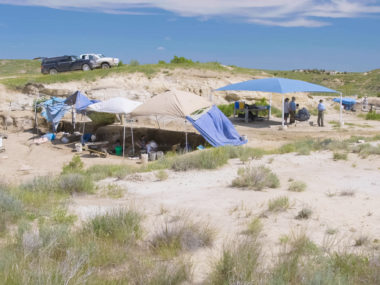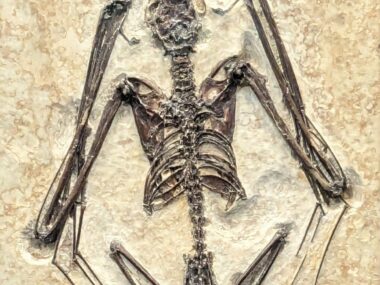The theory of plate tectonics arose in the mid-20th century, and quickly became accepted in the scientific community due to its explanatory capabilities. The earth’s crust, according to the theory, consists of a series of plates broken apart—fitting together to form a sort of three-dimensional puzzle.
The views expressed in this article reflect those of the author mentioned, and not necessarily those of New Creation.
The Continental Dance
From biostratigraphy to the fit of the continents, there is plenty of evidence that the world’s land masses once held an entirely different configuration from their modern placement. However, present-day rates show that the movement is incredibly slow—at the speed of only centimeters per year! This has led conventional geologists to conclude that plate tectonics is a slow process that has been occurring over millions of years throughout earth history. How, then, does a creationist deal with the data?
Dr. John Baumgardner took this question under serious consideration. Baumgardner is a geophysicist who studies geology and earth processes from a biblical perspective. He, along with many other creationists including Dr. Steve Austin, wanted to figure out how we should apply plate tectonics within a biblical Flood model. In 1990 they developed Catastrophic Plate Tectonics (CPT), which serves this purpose. It is an ongoing field of research, and it is still being developed and modified.
Slow or Fast?
CPT functions very similarly to the modern theory of plate tectonics. The major distinction between the two is the time involved. The latter maintains that crustal movement is a slow process that occurred over the vast expanse of earth history; that is, billions of years. CPT, while it does agree with a lot of the physical mechanisms of the modern theory, suggests that plate movement occurred very rapidly for the duration of the Flood.

According to CPT, the pre-Flood world likely looked something like Rodinia (though there is some debate, see Clarey’s model for example)—which was roughly a single supercontinent. Some catastrophic event—divine or natural—caused the dense, heavier ocean crust to start sinking rapidly under the continents via subduction. This rapid (sometimes called runaway) subduction occurred at rates as quick as meters per second while the pre-Flood ocean crust was entirely replaced. While this was happening, the supercontinent broke apart and likely re-converged to form Pangea underwater. As the Flood came toward an end, the continents were arranged similarly to their modern placement. Then, over the next millennia, the movement continued to slow down to today’s rates.
Footnotes
- Austin et al, 1994. “Catastrophic Plate Tectonics: A Global Flood Model of Earth History,” Proceedings of the Third International Conference on Creationism, 609–612.
- Baumgardner, 1994. “Runaway Subduction as the Driving Mechanism for the Genesis Flood,” Proceedings of the Third International Conference on Creationism, 63–86.
- Baumgardner, 1994. “Computer Modeling of the Large-Scale Tectonics Associated with the Genesis Flood,” Proceedings of the Third International Conference on Creationism, 49–62.
- Baumgardner, J. R. 2003. “Catastrophic Plate Tectonics: The Physics Behind the Genesis Flood,” Proceedings of the Fifth International Conference on Creationism, 113–126.
- Baumgardner, 2016. “Numerical Modeling of the Large-Scale Erosion, Sediment Transport, and Deposition Processes of the Genesis Flood,” Answers Research Journal 9, 1–24.
- Clarey, T. L. 2020. “The pre-Flood world resembled Pangaea,” Journal of Creation 34(2), 8–11.












Which flood are we talking about? Noah’s? I copy from the article: “As the Flood came toward an end, the continents were arranged similarly to their modern placement. Then, over the next millennia, the movement continued to slow down to today’s rates.”
Hello Ron,
Yes, we are talking about the Flood in Noah’s time, as we are every time whenever we use the word “Flood” where the “F” is capitalized. When we are speaking of a local or regional flood, we use a lowercase “f.”
Great article! May I suggest one small correction? Depending on what “quickly” means in the mind of your readers, I am old enough to remember being taught only geosynclinal mountain building processes in the 1970’s. As I recall, older geologists were slow to accept plate tectonics because it sounded too catastrophic.
I truly enjoyed reading the article on CPT. However, a serious student of this subject should also look at Dr. Walt Brown’s HydroPlate Theory, 9th Edition, on-line at http://www.creationscience.com. (It is Free!) Dr. Brown looks at the Flood from a physics and Engineering viewpoint as well as Biblical perspective. He shows that subduction does not work, it is an evolutionary construct that attempts to explain everything, yet there is much real scientific evidence against PT and thus CPT. Dr. Brown’s book “In the Beginning, Compelling Evidence for Creation and the Flood” is thoroughly documented; it reads very well and is written so that the average layman can understand its concepts and scientific terminology.
Also, CPT has to far too many assumptions and must invoke numerous miracles that are not in the Bible to make it work. Scientists should not invoke miracles to make something work. These are nothing but “rescuing devices” for a theory that has many scientific problems.
As a Retired Professional Engineer, with a love for Geology and the Scriptures, I heartily endorse Dr. Browns work. Please check it out. Thanks!
Hi John,
Thank you for reading and taking the time to comment! Plate tectonics is only a recently developed model (not even 100 years old!), and so it certainly does not answer all of the questions we have. However, it does an excellent job explaining earthquakes and volcanoes we see in particular patterns across the globe, seafloor spreading, etc. It is a theory widely accepted by most modern creationists (not the long ages of course, but the existence of plates that move and so forth). Dr. Andrew Snelling and others have discussed this extensively, like in this article here. I would encourage you to check into it!
As for Catastrophic Plate Tectonics, it is an even newer theory (introduced in the 90s) with few people working on it. Sadly, most creationists’ research faces similar challenges: lack of funding & research. It certainly has many problems (like the heat issue), but is the most robust theory currently in the creationist community. I think that it is a good start in building a scientific model for what was happening during the Flood.
As for the HydroPlate theory, very few creation geologists now hold to it. It also has not been submitted for peer review, and so has not been able to progress as a theory and undergo scientific process. While it may have some explanatory power, I cannot recommend a model that has not been tested and critiqued by other (creation!) scientists. However, I do intend to delve more into his theory and perhaps write on it in the future.
Thank you again for taking the time to comment! We appreciate your thoughts 🙂
Sara Anne
I don’t think it’s fair to say “CPT has to far too many assumptions and must invoke numerous miracles that are not in the Bible to make it work.” If you study Dr. Brown’s Hydroplate Hypothesis, it has an equal if not higher number of assumptions and miracles that are not in the Bible. For example, it offers no explanation for the extremely high volume of carbonate fossils in limestones. Numerous times, it cites a particular feature in the geologic record and then says “the hydroplate theory explains that,” but then it never gets around to providing an explanation.
I was introduced early to the Hydroplate Theory, even brought it up to Ken Ham, when he visited my college around 1990. Ham was wisely cautious not commit himself to a peripheral theory. I have no beef with the theory. “Scientists should not invoke miracles to make something work,” is the statement that I question. Evolutionism invokes, consciously or unconsciously, numerous miracles: No matter to all matter. Nowhere to everywhere. Non life to programmed cellular life. A single cell programs itself to replicate. A single cell transforms itself into every living micro/macro plant and animal that has ever existed, etc. etc. All these claims are miracle level assumptions necessary to propose there, “theory of change.” By your definition, there are no scientists. I understand that the fewer unprovable assumptions invoked, the greater the acceptance will be among Atheistic Materialistic Naturalists. God’s hand (words) is a very powerful instrument, responsible for calling the entire universe and life into existence. He could have utilized that authority over nature at any moment. Having said that, the more we can explain apart from God’s specific activity will most likely discern what actually happened. And isn’t this one of the goals of true science? Sorry for rambling.
Sara,
congratulations on your degree and your work on this article. I would like to use it in part or in total in an on-line book on creation science for high school level Christian home schoolers. It will cover biology, geology, fossils, etc. I will send a draft for your comments when it is ready.
Blessings,
Craig
Let’s not forget to give Antonio Snider-Pellegrini his due (He is referenced in the 1994 article on CPT so I know you know of him ) In 1859 in his book The Creation and it’s Mysteries Unveiled he was the first to propose Plate Tectonics but from a Flood perspective. I would say the current CPT is a continuation of the Original 1859 idea.
As I have attempted to share this area of Flood history with Evolution practitioners on Creation/Evolution websites, eventually a more experienced person will enter the conversation, claiming that the heat generated by fast tectonic plate movement would have cooked the planet. I’m no scientist, but I believe they might just have a point. Perhaps Creationists should adjust the heat inputs during the flood, to exhibit more tectonic than volcanic inputs. Also, this heating through movement could explain features like Specimen Ridge, where hundreds of trees were buried in upright position but staggered strata, yet all the trees exhibit the same level of agatized replacement. This massive heat generated could also explain how the layers hardened, and the growth of crystals. The existence of agates, especially anhydrous agates, copper and other metal layers with their byproducts and ores could be the result of tectonic heat smelting the metals in areas. Just some thoughts.